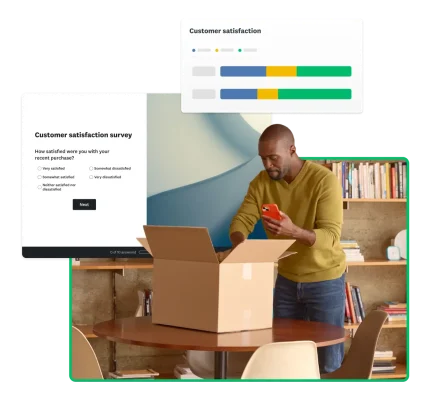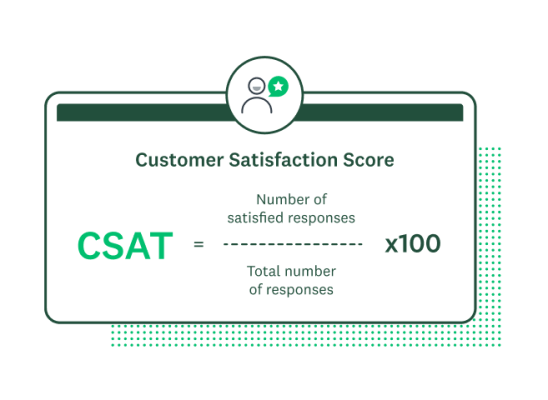Calculate customer satisfaction with our CSAT calculator
Discover what CSAT is, how to measure it, and ways to enhance customer satisfaction using our free CSAT calculator.

CSAT Calculator
Measure your Customer Satisfaction Score with our easy-to-use CSAT calculator.
Very dissatisfied
Dissatisfied
Neutral
Satisfied
Very satisfied
Your CSAT:
0
For most businesses, the primary concern is whether their customers are satisfied with their products and services.
Customer satisfaction is essential to sustaining a successful business but remains a significant challenge. Nearly half of customer experience (CX) professionals identify meeting and exceeding customer expectations as their top priority.
Businesses rely on the Customer Satisfaction Score (CSAT) to evaluate customer satisfaction. CSAT survey insights enable teams to improve the customer experience, benefiting customers and businesses.
Use our customer satisfaction calculator above to measure your CSAT.
What is CSAT?
The Customer Satisfaction Score (CSAT) is a CX metric that measures satisfaction with your business's products, services, and experiences.
What is the CSAT scale?
There are a variety of ways you can conduct a CSAT survey. Teams typically use a numerical scale to gauge customer feelings about their products and services.
Typically, a CSAT survey includes a simple question like, “How satisfied are you with our business?
Respondents choose from a scale—usually from 1-5—to indicate their level of satisfaction:
- 1 represents “Very Unsatisfied”
- 2 represents “Unsatisfied”
- 3 represents “Neither Unsatisfied nor Satisfied”
- 4 represents “Satisfied”
- 5 represents “Very Satisfied”
Some businesses use a slightly different scale, like 1-7, 1-10, or even emoji ratings. Businesses generally prefer numerical scales, which are simple and intuitive for the survey administrators and the respondents.
How is CSAT calculated?
The CSAT formula is simple. Take the number of satisfied responses and divide this figure by the total number of responses. Then, multiply that value by 100 to get a percentage.
You need to know two things to calculate your CSAT score:
- The number of satisfied customer responses. If you’re using a scale of 1-5, a 4 or a 5 will be a satisfied response.
- The total number of people who responded to the survey.

For example, a shoe store receives 100 responses to customer satisfaction surveys. Eighty-two responses are satisfied or very satisfied, respectively 4 or 5. The CSAT score is 82%.
How to interpret your CSAT score
What is a good CSAT score? Generally, a high CSAT score correlates with satisfied customers.
- A score above 90% indicates that most customers are highly satisfied.
- A CSAT score of 75% to 89% indicates that most customers are satisfied, but there’s room for improvement. Follow up with less-satisfied customers to gather qualitative feedback on how to enhance their experience.
- A score between 50% and 74% highlights recurring customer pain points that need attention. Analyze these responses for trends and request qualitative feedback to uncover the root causes of dissatisfaction.
- A score below 50% indicates a need to reassess your customer experience. Step back to evaluate the customer journey and your products and services.
These guidelines are loose, and you should consider several outstanding factors.
You should evaluate CSAT scores as more than just an isolated data point. They are a part of a comprehensive assessment of your business performance. A higher score than before indicates improved customer experience, even if the score is still low overall.
You should also evaluate CSAT scores in terms of industry benchmarks. For example, ecommerce and retail typically aim for higher CSAT scores to achieve 80%-90%. However, 70% to 80% is often the norm for technology and software companies.
Finally, compare CSAT scores to other CX metrics like Net Promoter Score (NPS®) and Customer Effort Score (CES). This approach provides a more holistic snapshot of your business performance and highlights areas for improvement.
How to collect CSAT data (8 ways to send a CSAT survey)
CSAT data can be collected in myriad ways. Here are a few ideas to kickstart your survey distribution.
1. Web link
Share the survey through emails, flyers, social media, product packaging, or receipts using a URL or QR code.
2. Email invitation
Surveys can be distributed to a targeted pool of respondents through personalized email invitations. Simply include the survey link in the body of the email. This method makes it easy to track which customers have participated.
3. Social media
CSAT surveys can be shared as status updates or posts on social media platforms like Facebook and LinkedIn. That way, you can reach customers where they are and amplify the post to reach a wider audience.
4. Facebook Messenger
Deliver the survey using a Facebook Messenger chatbot to collect real-time responses. This fast and dynamic method delivers immediate feedback and generates high response rates.
5. Website
Share the survey by embedding a link on your website or triggering a pop-up for visitors. Interactions like a checkout or content download can trigger pop-ups.
6. Manual data entry
By sharing the survey manually, you can collect responses offline via paper forms, in-person interviews, or phone calls. This method reaches respondents without reliable internet access or those less comfortable with digital responses.
7. Mobile SDK
Developers can use this method to integrate CSAT surveys into mobile apps using a Software Development Kit (SDK). The SDK prompts customers to complete the survey after they purchase an item or finish a task. This method provides a frictionless experience that captures customer sentiment at key points in the user journey.
8. Text message
You can send a survey link via SMS, allowing mobile users to complete the survey quickly and conveniently.
When to collect CSAT data
Timing is just as crucial as survey content to boost response rates and collect valuable data. These are the best times to survey customers for satisfaction data.
- Post-interaction: Distributing a survey right after a customer service interaction captures feedback while it's still fresh.
- After a purchase: Sending a survey after a transaction enables you to gain insights into the purchasing experience. You can then identify pain points in the checkout process.
- After specific events: Collect CSAT data right after an event like a training, webinar, or onboarding session. This empowers you to get targeted feedback about the customer’s experience immediately following these interactions.
Why should you use a CSAT calculator?
Using a CSAT calculator formula to automate calculations lets you measure customer satisfaction quickly, accurately, and at scale. Here are some benefits of using CSAT calculators.
- Accuracy: Reduce human error and ensure precise measurement.
- Consistency: Standardize your measurements so you can seamlessly and accurately track customer satisfaction over time.
- Scalability: Process large volumes of data at once.
- Efficiency: Quickly process data to turn numbers into insights more quickly.
7 reasons why measuring CSAT is important
Tracking CSAT scores is crucial for any brand looking to retain customers, build loyalty, reduce churn, and achieve success. Here are some reasons you should measure and track CSAT over time.
1. Keep pace with customers' evolving needs and preferences
Customer needs and preferences are not static. They change in response to market developments, economic shifts, emerging technologies, and industry trends. CSAT surveys allow you to track your customers' needs, ensuring you offer experiences that resonate with your base.
2. Improve customer retention and lifetime value
The customer lifetime value (CLV) is the total revenue you can generate from their interactions with your business. You can increase CLV and boost retention by tracking customer satisfaction, proactively addressing pain points, and reducing churn.
3. Increase word-of-mouth referrals by boosting satisfaction
Satisfied customers are more likely to spread the word about your business, increasing organic growth. Measuring CSAT allows you to boost word-of-mouth referrals by tracking what resonates with your customers.
4. Identify strengths and weaknesses in processes
CSAT surveys, especially combined with qualitative data or NPS, offer valuable insights into your business's strengths. They also highlight areas where your business could improve.
5. Support data-driven business decisions
Data-driven insights empower your business to make choices that deliver tangible impact. By monitoring customer satisfaction, CSAT scores provide actionable data so your business can allocate resources effectively.
6. Enhance product development with customer feedback
Customer feedback is vital for product development. Gathering feedback can enable product teams to understand better how to improve products or services.
7. Monitor the effectiveness of marketing and brand messaging
Tracking CSAT allows businesses to tailor their messaging to their customers’ preferences. CSAT scores provide a reliable indication of whether your brand promises align with customer expectations.
Improve customer satisfaction with SurveyMonkey
A good customer experience has been linked to lower churn, higher revenue, and greater customer lifetime value. Improving customer experience—and achieving customer satisfaction—is necessary for a company to survive and thrive.
Sign up for SurveyMonkey for free to start improving customer satisfaction today!
NPS, Net Promoter & Net Promoter Score are registered trademarks of Satmetrix Systems, Inc., Bain & Company and Fred Reichheld.
Ready to get started?
Discover more resources

Customer satisfaction survey templates
Explore our customer satisfaction survey templates to rapidly collect data, identify pain points, and improve your customer experience.

Customer Behavior Analysis: A Complete Guide and Examples
Read our step-by-step guide on conducting customer behavior analysis. Learn how to collect data and improve customer touchpoints.

Empowering CX professionals: Using insights to overcome frontline challenges
Empower your CX team with actionable insights! Watch our webinar for expert strategies on boosting performance and morale.

How to measure & improve CSAT call center scores
Meet customer expectations and create lifelong customers! Learn how to measure call center CSAT and improve customer satisfaction with SurveyMonkey.